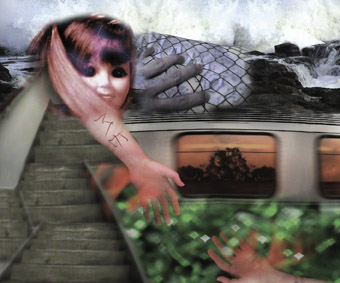New media dreaming
Roy Ananda

Lynne Sanderson, Lucid Touch
Out of the Body Encounters brought the intermediary states of comas, dreams and nightmares into the waking world by way of 3 video and new media works. Curated by EAF director Melentie Pandilovski, the exhibition offered 3 distinct speculations on states of existence between life and death, the conscious and unconscious.
Lynne Sanderson, digital artist, VJ and lecturer in New Media at the South Australian School of Art presented an exciting proposition in her work, Lucid Touch. A bio-electrical interface registers the viewer’s sweat, heart-rate, and temperature and responds by triggering one of 17 pre-recorded dream sequences. In this way, Sanderson sets up a direct cause and effect relationship between the body’s quantifiable data and the ineffable, unpredictable nature of dreams. This gives viewers a notional out-of-body experience that is paradoxically tied intimately and rigorously to their own body. The viewer’s tangible physicality becomes a membrane between the dream world and the real one.
In creating the work, Sanderson collaborated with the Centre for Sleep Research to collect dreams from a group of volunteers. These laboratory-harvested dreams were then translated into film and have arguably suffered in translation. Performed by attractive young actors, with an electronic soundtrack and stylised pixilation, the sequences feel more like music video clips than filmic analogues of the dream state. For the most part, the sequences depict plausible situations and linear narratives; strangely, there is little of the eccentric logic of dreams, with their sudden shifts in time, space and subject matter.
Lucid Touch seems to be a propositional version of an ongoing project: a draft of a much more ambitious, dynamic and responsive future state. While the ‘experimental’ nature of much of the work shown at the Experimental Art Foundation might be questionable, Sanderson’s piece represents a genuinely speculative and exploratory work.
Dennis Del Favero’s Deep Sleep deals with a nightmarish chapter in Australian medical history: the strange case of Sydney’s Chelmsford psychiatric hospital and its practice of Insulin Coma Therapy. Between 1962 and 1979 at least 40 people died while undergoing this treatment, which involved putting patients into a 6-week long coma. Del Favero’s response to the incidents is an interactive DVD-ROM in which disembodied fragments of memory and nightmare are combined to recount these dreadful events.
Projected on the wall of a darkened space, the DVD is set in motion by clicking on a hovering cursor which in turn triggers various short vignettes. In highly theatrical style (ranging from film noir-like mode to A Current Affair-style re-enactments) they depict incidents in the hospital and in the aftermath, as well as speculating on the dreams of the comatose patients. On one hand, the interactive element of the work seems slightly arbitrary; potentially, the piece would have been just as successful as a conventional piece of film-making. However, the viewer’s part in causing the work to unfold implicates them in these events (in some small way) and also serves to fragment the experience. In this way perhaps, the work approaches an analogue of the patients’ experiences and of the non-linear nature of memory.
Based in Germay, artists Alexander R Titz and Maja Sokolova presented das Ich von Gestern (‘The I From Yesterday’ or ‘My Yesterday’s Self’). Sheets of glass housed in metal frameworks and hung with tiny speakers received dual projections of a male and female figure. A fuzzy, static-drenched beam of light relentlessly scanned the squirming, shifting figures, seemingly alluding to interrogation, searchlights and the scanning of bar codes. The sound element of the work comprised 2 sets of EEG signals—one from someone living and the other from a brain dead person—locating at least one of the projected figures in a grey netherworld between life and death. Like the other works in the exhibition, das Ich von Gestern seemed haunted by a ghost in its machinery; the sound and projection stalled and stuttered with poetic imperfection. The work was undeniably the most potent physical presence in the space; incredibly satisfying as a sculptural object.
The high profile of new media and video-based work has had the unfortunate side-effect of spawning countless video installations that seem to excuse themselves from the craft, conventions and critical criteria of both video and installation. Hence, at times, one feels inundated with sloppily made films installed with little regard for spatial/sculptural concerns. Not so with Out of the Body Encounters. Rather than validating themselves with their own newness or technical innovation these works thoroughly engage the craft and conventions of film-making, the poetics of objects and space and some rich, complex subject matter.
Out of the Body Encounters, curator Melentie Pandilovski, artists Lynne Sanderson, Alexander R Titz & Maja Sokolova, Dennis Del Favero, Experimental Art Foundation, July 14-Aug 3
RealTime issue #69 Oct-Nov 2005 pg. 24






